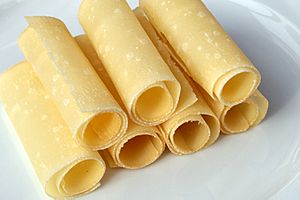Berner Alpkäse facts for kids
Quick facts for kids Berner Alpkäse |
|
|---|---|
 |
|
| Other names | Berner Hobelkäse |
| Country of origin | Switzerland |
| Region | Canton Berne |
| Source of milk | Bernese Alps |
| Pasteurised | no |
| Texture | hard and very hard |
| Fat content | 45% |
| Weight | 15 kg (33 lb) |
| Aging time | 6 to 30 months |
| Named after | Lua error in Module:Wikidata at line 70: attempt to index field 'wikibase' (a nil value). |
Berner Alpkäse is a special kind of hard cheese from the Bernese Oberland in Switzerland. It's known as a "Swiss-type" or "Alpine" cheese. This cheese is full of flavor, made from raw milk, and doesn't have holes like some other Swiss cheeses.
What makes it unique? It's made by hand, often over a wood fire! There's also an extra-hard version called Berner Hobelkäse. This one is aged for at least two years. Both Berner Alpkäse and Berner Hobelkäse are protected by Swiss rules. These rules make sure they are made in a special way in their original region.
Contents
What Makes Berner Alpkäse Special?
Berner Alpkäse is made only on special farms high up in the Bernese Alps. These farms are used during the "Alpine season" when cows graze there. The milk comes from cows that eat fresh grass and herbs. These pastures are never treated with artificial fertilizers.
The Secret of Alpine Milk
The Alpine herbs give the milk a very rich flavor. This milk is also healthier. It has more of certain good fats than milk from cows in lower areas. This special milk is key to the cheese's unique taste.
How Berner Alpkäse is Made
Making Berner Alpkäse is a careful process. The cheese must be started within 18 hours after the cows are milked.
From Milk to Curds
First, the chilled evening milk is partly skimmed. This helps the final cheese have at least 45% fat. Then, it's mixed with fresh morning milk. The milk is gently warmed to about 33 degrees Celsius (91°F). Special bacteria from the region are added. These help the milk turn into cheese. Then, rennet is added. Rennet is a natural substance that makes the milk curdle.
After about 30 minutes, the milk has turned into soft lumps called "curds." The liquid left behind is called "whey." The cheesemakers use a tool called a "cheese-harp" to cut the curds into tiny, pinhead-sized pieces.
Pressing and Salting
Next, the curds and whey are heated to about 50 degrees Celsius (122°F). This heat makes the curds shrink. It also kills any unwanted bacteria. The curds are then put into a round cheese mold. They are pressed for about 15 hours. This squeezes out more whey and forms the cheese into its round shape.
After pressing, the big cheese wheel is soaked in salty water called "brine." It stays in the brine for 24 hours. This adds flavor and helps form the rind. Each cheese wheel weighs at least 15 kilograms (about 33 pounds).
The Aging Process
The cheeses are then moved to a special room. It has high humidity, over 85%. The cheesemakers regularly brush the rind with brine. This helps the cheese ripen. The first part of aging happens right where the cheese is made. Later, the cheese is moved to special cellars. These cellars belong to cheese sellers and dairies.
After 6 to 18 months, the Berner Alpkäse is ready to eat. For the extra-hard Berner Hobelkäse, it ages for at least one more year. This second aging happens in a drier place. During this time, the rind is no longer washed.
Berner Hobelkäse: The Extra-Hard Kind
Berner Hobelkäse is a very hard version of Berner Alpkäse. It's aged for at least two years. This long aging makes it very firm and brittle.
How Berner Alpkäse is Enjoyed
Most Berner Alpkäse is eaten in slices. It's great for sandwiches or cheese boards.
Berner Hobelkäse is too hard to slice with a knife. Instead, it's often shaved into thin, delicate rolls. People use a special tool to "plane" it. You can also crumble it into small pieces. It's delicious on salads or pasta.
Berner Alpkäse vs. Sbrinz
Berner Alpkäse is quite similar to another Swiss cheese called Sbrinz. However, Sbrinz is made in the lowlands of Switzerland. It's also much saltier than Berner Alpkäse. This is because Sbrinz is soaked in brine for a much longer time, usually 15 to 20 days.
Images for kids


